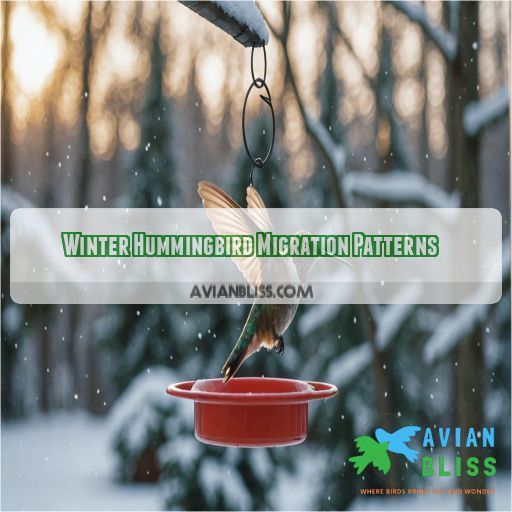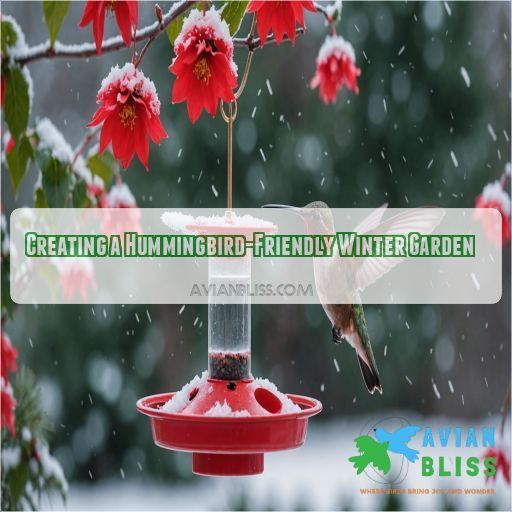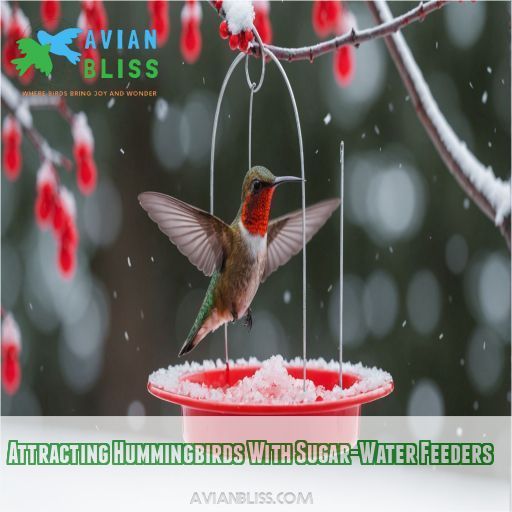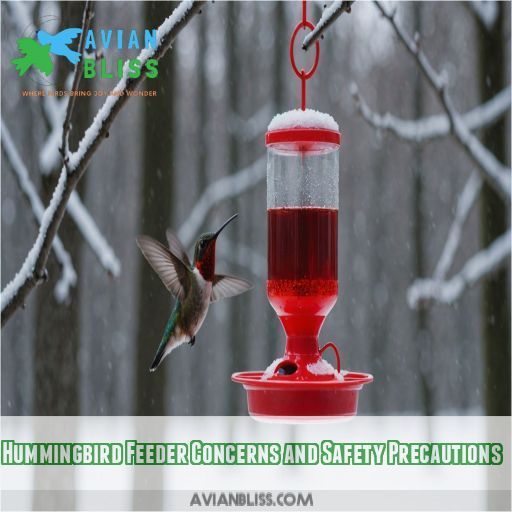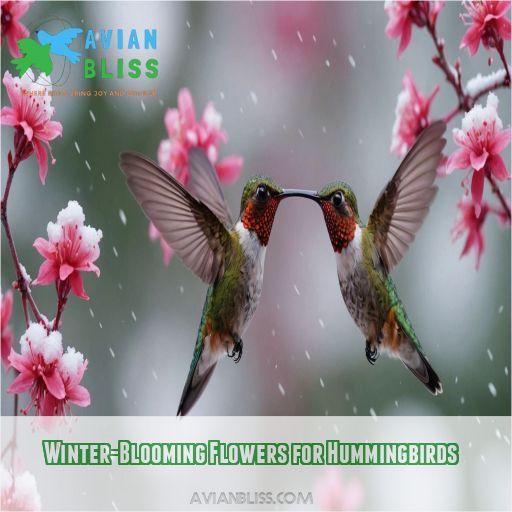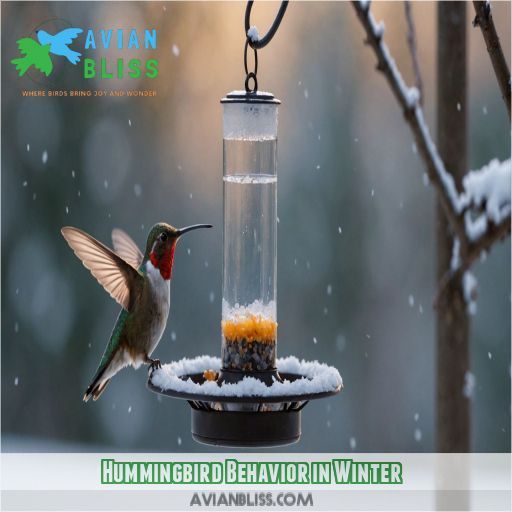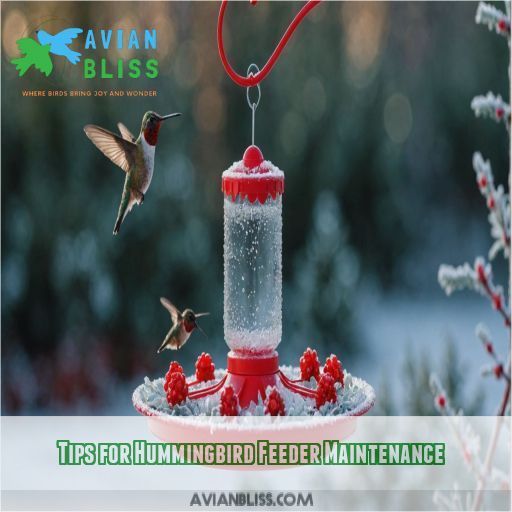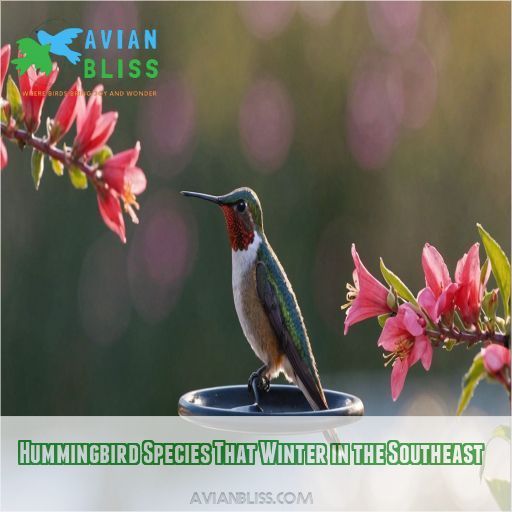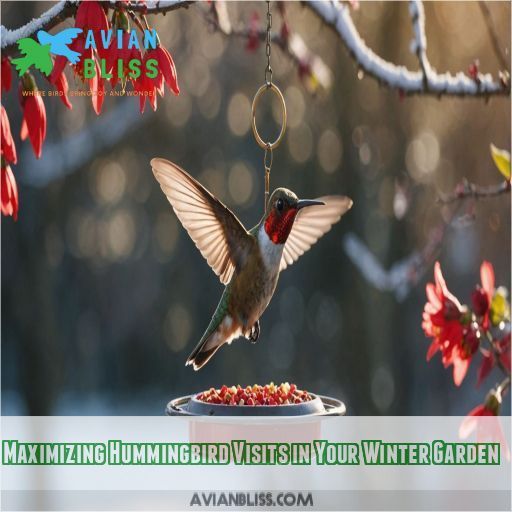This site is supported by our readers. We may earn a commission, at no cost to you, if you purchase through links.
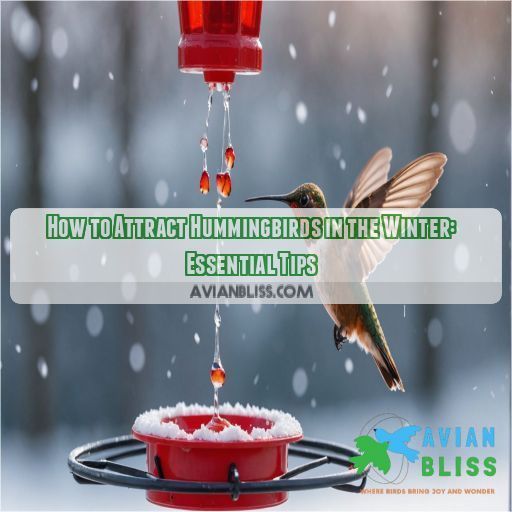 If you want to know how to attract hummingbirds in the winter, think of your garden as their cozy winter getaway.
If you want to know how to attract hummingbirds in the winter, think of your garden as their cozy winter getaway.
Plant hardy, red-flowered nectar sources like fuchsias and salvias. It’s like waving a bright red flag saying, "Hummingbird Buffet Here!"
Set up sugar-water feeders, but keep them clean and consider a heated version to prevent freezing.
Shelter your guests with windbreaks and evergreen shrubs.
Water sources? Yes, please! Just like a bird spa!
With these measures, you’ll have hummingbirds partying all winter long.
Curious what flowers withstand cold? Keep reading to transform your garden into a hummingbird magnet!
Table Of Contents
- Key Takeaways
- Winter Hummingbird Migration Patterns
- Creating a Hummingbird-Friendly Winter Garden
- Attracting Hummingbirds With Sugar-Water Feeders
- Hummingbird Feeder Concerns and Safety Precautions
- Winter-Blooming Flowers for Hummingbirds
- Hummingbird Behavior in Winter
- Tips for Hummingbird Feeder Maintenance
- Hummingbird Window Collisions and Safety Measures
- Hummingbird Species That Winter in the Southeast
- Maximizing Hummingbird Visits in Your Winter Garden
- Frequently Asked Questions (FAQs)
- Should you put hummingbird feeders out in the winter?
- How do I get hummingbirds to come to my feeder?
- How long will it take for hummingbirds to find my feeder?
- What plants attract hummingbirds in the winter?
- What are the ideal locations for winter feeders?
- How to deter other animals from hummingbird feeders?
- Can hummingbirds recognize specific gardens or yards?
- Do artificial flowers help attract hummingbirds?
- Why do some hummingbirds stay in colder climates?
- Conclusion
Key Takeaways
- Think of your winter garden as a cozy retreat for hummingbirds. Plant red-flowered, nectar-rich blooms like salvias and fuchsias to look like you’re waving a favorite neighborhood bakery flag that’s irresistible to them!
- Set up and maintain sugar-water feeders with the perfect nectar mix (1 part sugar to 4 parts water). Keep them clean (like your grandma’s prized teapot) and consider heated options to prevent turning their food into popsicles.
- Provide shelter with evergreen shrubs or windbreaks to protect these delicate guests from harsh weather. Your garden can be their snug winter hideaway, perfect for escaping cold winds and rain.
- Add shallow water sources – imagine offering a refreshing spa experience. Keep them clean and strategically placed away from direct wind, ensuring your garden becomes an irresistible hummingbird hotspot.
Winter Hummingbird Migration Patterns
To attract hummingbirds in winter, understanding their migration patterns is keythink of your garden as a five-star hotel on their snowy trek. With gardeners creating cozy havens, you’ll see more western species like the rufous hummingbirds popping by the eastern U.S., turning your backyard into their winter spa retreat.
Rufous Hummingbird Migration Routes
Rufous hummingbird migration patterns can surprise you with their magical journey south. As fall approaches, they fly through the Rockies, heading for Mexican wintering grounds. To help them, create an inviting hummingbird habitat with feeders and flowers. Your garden could become their pit stop!
Eastern Expansion of Western Hummingbirds
As western hummingbirds like the rufous expand their range eastward, they’re increasingly wintering in the Southeast. This fascinating trend is driven by the creation of hummingbird-friendly gardens, which provide essential food and shelter during the colder months.
Impact of Gardeners on Hummingbird Migration
Gardeners are the real game-changers in hummingbird migration! Providing winter-blooming flowers and feeders, you’ve transformed your backyard into a hummingbird habitat. These little wonders now deviate from their usual migration patterns, and you’re the mastermind behind it!
- Year-round blooming plants
- Feeder impact
- Climate change adaptation
- Vibrant garden adventures
Creating a Hummingbird-Friendly Winter Garden
Creating a hummingbird-friendly winter garden is like throwing a year-round garden party for these little feathered guests, where your blooms are the buffet and your cozy spaces are the perfect shelter. By choosing hardy plants and ensuring there’s fresh water available, you’ll keep the hummingbirds coming back even when the temperature drops.
Planting Hardy Nectar Sources
To keep hummingbirds happy through winter, plant hardy winter flowers that act as reliable food sources. Check local nurseries for nectar-rich native plants. You’ll discover this simple trick provides easy hummingbird nourishment without a hitch.
Choosing Red Flowers for Hummingbirds
Hummingbirds adore red flowers! Plant winter-blooming red varieties like fuchsias, hibiscus, and salvias to attract these feisty flyers. The vibrant hues are irresistible to their keen eyes.
- Choose red winter bloomers
- Hummingbirds love the color
- Red flowers are a magnet
Providing Shelter From Wind and Rain
To protect your feathered friends from cold winds and rain, plant evergreen shrubs as natural barriers. Shelterbelts or windbreaks can provide essential cover, ensuring hummingbirds like those in British Columbia and the Rocky Mountains thrive, regardless of weather whims.
Offering Fresh Water Sources
Once you’ve created shelter, water is essential. Offer fresh water sources to attract winter hummingbirds. Consider:
- Shallow dishes (depth matters).
- Best placement (avoid direct wind).
- Regular cleanliness checks.
- Maintenance is key.
Follow these secret hummingbird techniques and watch them flock!
Attracting Hummingbirds With Sugar-Water Feeders
To attract hummingbirds during the chilly winter months, be sure to offer sugar-water feeders with the right nectar recipe to keep these tiny aviators coming back for more. Keep your feeders as pristine as your grandma’s favorite teapot by cleaning them regularly and consider investing in heated feeders so the nectar doesn’t turn into a hummingbird popsicle!
Using the Right Sugar-to-Water Ratio
Get the sugar-to-water ratio just right – 1 part sugar to 4 parts water. This sweet solution will keep your hummingbird friends fueled up all winter long. No need for fancy store-bought nectar when you can whip up a homemade batch!
Keeping Feeders Clean and Free of Mold
After perfecting your sugar-water ratio, pay close attention to keeping feeders spic and span. Use vinegar for cleaning and to prevent mold. Keep an eye on feeder materials to make sure they stay clean and inviting, even near the Gulf Coast.
Heated Feeders for Year-Round Nectar
In the depths of winter, heated feeders provide hummingbirds with warm, year-round nectar. With these nifty gadgets, you’ll help your tiny feathered friends avoid icy troubles. Remember, consistent feeder maintenance prevents dependence, offering winter safety for hummingbirds across the Great Plains.
Tips for Feeder Placement and Maintenance
While heated feeders can help, choosing the perfect feeder spot makes a difference.
- Feeder Height: Hang at about eye level.
- Feeder Location: Keep near shrubs for safety.
- Ant Prevention: Use moats or ant guards.
Hummingbird Feeder Concerns and Safety Precautions
While hummingbird feeders can be a lifeline in winter, you’ll need to take some precautions to make sure their safety and keep those pesky bees away
. Frozen nectar can be deadly, so heated feeders are a must if you want to provide year-round sustenance. And be mindful not to let hummingbirds become overly dependent on your handouts – they need to maintain their natural foraging instincts.
Preventing Hummingbird Dependence on Feeders
To prevent hummingbird dependence on feeders, offer alternative food sources like natural nectar blooms. Gradually reduce feeder availability, encouraging birds to diversify their diet. Imagine feeders as training wheels—they provide initial support but aren’t a crutch. Smart feeder placement helps you support their independence!
Avoiding Frozen Nectar and Hummingbird Death
Just like you wouldn’t leave an ice cream cone out in winter, don’t let nectar freeze. Use heated feeders to keep your winter nectar flowing and hummingbird guests safe. Strategic feeder placement, away from the coldest spots, helps avoid frozen nectar and makes sure hummingbird safety.
Safe Feeder Materials and Construction
While discussing feeder safety, think of feeders like kitchen gadgets—they should be user-friendly and reliable. Consider:
- Plastic vs. Glass: Glass is durable and doesn’t absorb odors.
- Feeder Placement: Place strategically to avoid predators.
- Ant Moats: Keep ants away, letting hummers sip in peace.
Winter-Blooming Flowers for Hummingbirds
Hummingbirds are drawn to vibrant, nectar-rich blooms, even in the chilly winter months. By planting a selection of hardy, winter-flowering plants, you can create a veritable hummingbird haven right in your own backyard.
Choosing Plants That Withstand Cold Temperatures
To keep your garden buzzing in winter, choose cold-hardy flowers like hellebores and winter honeysuckle. These champs thrive despite frost. Prefer plants with zone-specific adaptations and good frost tolerance. Picking the right blooms means your garden stays lively, even Jack Frost won’t stand a chance!
Planting in Clusters for Maximum Attraction
Planting in clusters is like throwing a party where every flower is an entertainer. Hummingbirds adore bold flower colors, so group them tightly. Observe their behavior as they flit between clusters, enjoying the visual cue buffet. Mind your plant spacing; overcrowding isn’t ideal. Enjoy their lively visits!
Recommended Winter-Blooming Flowers for Hummingbirds
Cluster planting will fascinate hummingbirds, but picking the right flowers seals the deal. Opt for cold-hardy varieties like winter honeysuckle, hellebores, or mahonia. They’re nectar-producing champs with a flair for surviving chills. Plus, their bold colors captivate those speedy fliers just like a rainbow entices dreamers!
Hummingbird Behavior in Winter
As the weather cools, hummingbirds exhibit some fascinating behaviors to survive the winter. Observe how they communicate with their high-pitched chirps, defend their territories, and even engage in courtship displays – a delightful sight for any winter gardener.
Understanding Hummingbird Social Structure
When you think about hummingbird social structure, imagine a tiny kingdom. Despite their size, they establish territories fiercely.
- Courtship rituals are dazzling displays.
- Social hierarchy determines feeding order.
- Nesting behavior involves a lot of patience.
- They’re masters of quick escape strategies.
- Territorial disputes can resemble aerial duels!
Recognizing Hummingbird Communication Signals
Ever wondered what those tiny feathered friends are trying to say? Hummingbird calls, wing movements, and feather displays are their way of chatting. They’ll buzz like your nosy neighbor or dance like no one’s watching. Observe these signals to decipher their territorial behavior and courtship rituals.
| Calls | Wing Movements | Feather Displays |
|---|---|---|
| Buzzing alerts | Fast wing beats | Fluffed up chest |
| Chirruping calls | Hovering | Sleek feathering |
| Squawking disputes | Ascending swoops | Fanned tail |
| Thoughtful chit-chat | Flicking | Vibrant spread |
| Sweet sounds | Broad glides | Gleaming colors |
Observing Hummingbird Mating and Breeding Habits
Hummingbird courtship displays are like nature’s own aerial ballet, especially noticeable outside the typical breeding season. While winter isn’t their usual breeding time, you’ll spot fascinating hints of nesting behavior. Marvel at their skillful maneuvers as they prepare nests, highlighting chick development and parental care with flair.
Tips for Hummingbird Feeder Maintenance
Keeping your hummingbird feeders clean and well-maintained is really important for the health and safety of your feathered friends. From using the right vinegar-water solution to replacing nectar regularly, these simple steps will make sure your backyard oasis remains a welcoming haven for your tiny, high-energy visitors.
Cleaning Feeders With Vinegar and Water
While hummingbirds are buzzing about your winter garden, it’s imperative to keep their feeders gleaming. Mix a bit of vinegar (about a 1:4 vinegar-to-water concentration) to clean them, deterring mold. Regular cleaning using this method keeps feeders safe, just like vinegar keeps pesky mildew from your tent!
Replacing Nectar and Cleaning Feeders Regularly
Clean feeders regularly. Mold is a no-go, so mix that sugar-water right! Replacing hummingbird nectar often keeps your feathery friends delighted.
- Use a 1:4 sugar-to-water ratio.
- Clean feeders with vinegar and water but never soap.
- Make sure no residue attracts unwanted guests.
Avoiding Ants and Other Pests
Ants and other pests crashing your feeder party? Try using ant-proof feeders or natural deterrents like a light oil barrier. DIY solutions include placing water moats above hangers. Smart feeder placement—away from trees and fences—also helps control unwanted guests. Keep your nectar safe and inviting!
Hummingbird Window Collisions and Safety Measures
As you work to attract hummingbirds to your winter garden, it’s important to be mindful of potential window collisions. These tiny birds can easily mistake reflective glass for open space, leading to dangerous and sometimes fatal impacts. Fortunately, there are simple steps you can take to create a collision-free hummingbird habitat.
Understanding the Causes of Hummingbird Window Collisions
Cleaning your hummingbird feeders is just one step to bird safety, just like understanding bird travel regulations
. Ever wonder why hummers crash into windows? It’s all about window reflections and bird vision—don’t be fooled! Nesting birds mistake glass patterns and landscape design for open territory, triggering collisions. Predator mimicry confuses them further. ✨
Installing Window Decals and Other Safety Measures
Wondering how to prevent hummingbird window collisions? Simple tricks like window decals or bird-safe glass can make a world of difference. Imagine your windows as invisible traps; you wouldn’t want a feathery friend to crash into them! Follow these safety tips to reduce hummingbird hazards effectively.
Creating a Collision-Free Hummingbird Habitat
You’ve stuck up window decals, but don’t stop there! Use bird-safe glass to prevent collisions and place clear feeders away from reflective surfaces. Keep safe landscaping in mind, offering a garden that’s welcoming and protective for your feathered friends. Happy hummingbird hosting!
Hummingbird Species That Winter in the Southeast
As the Southeast sees an influx of hummingbird species from the West, it’s important to know how to identify these feathered visitors. From the vibrant rufous to the diminutive calliope, understanding the unique characteristics of each species can help you tailor your garden to attract the hummingbirds you hope to spot.
Identifying Rufous, Calliope, and Broad-Tailed Hummingbirds
Spotting these charming visitors is like playing detective. For hummingbird identification, observe the rufous’s fiery plumage, the calliope’s tiny size, and the broad-tailed’s shimmering colors. Compare size and search for preferred gardens or feeders. Understanding these birds’ habits lets you appreciate their winter stay in the Southeast.
Understanding Hummingbird Species Distribution and Range
Hummingbird enthusiasts, rejoice! Understanding hummingbird migration patterns and the Western hummingbird expansion reveals much about their winter behavior. Gardeners play a key role, fostering a colorful dance of hummingbird diversity. Historically, these tiny travelers are skipping state lines, redefining what it means to be home for winter.
Tips for Attracting Specific Hummingbird Species
To charm a calliope hummingbird, plant bright blossoms they fancy. Annas hummingbirds, your evergreen guests, prefer flowers paired with feeders. Rufous ones fancy tucked-away, bushy spots. For black-chinned, locate feeders high—where they dine. Broad-tailed neighbors? Offer cozy sheltered spots for nesting. It’s nature nearby!
Maximizing Hummingbird Visits in Your Winter Garden
Maximizing Hummingbird Visits in Your Winter Garden
With a few simple tweaks, you can transform your winter garden into a hummingbird haven. From strategically placing feeders to providing supplementary food sources, these essential tips will have those tiny feathered friends flocking to your backyard all season long.
Optimizing Feeder Placement and Nectar Quality
You’ve spotted various hummingbird species; now it’s feeder finesse time! Hang feeders at chest height for easy refills. Choose eye-catching colors like red, and designs that discourage pesky ants. Keep nectar fresh, with a consistent mix. Trust me, hummingbirds will flock faster than bees to honey!
Creating a Hummingbird-Friendly Garden Layout
Creating a hummingbird-friendly garden is like throwing a party they’ll never want to leave. Think carefully about plant selection, incorporating clusters of vibrant blooms. Consider shelter placement to keep wind out and spirits high. Make sure water sources sparkle nearby, and place feeders in the best spots for frequent visits.
Providing Supplementary Food Sources for Hummingbirds
To boost hummingbird visits, explore homemade nectar recipes. Think of it as a buffet just for them! Consider:
- Feeder placement tips: Keep ’em accessible and safe.
- Feeder types: Choose wisely.
- Nectar alternatives: Variety’s the spice of life!
- Hummingbird diet: Balance is key.
Frequently Asked Questions (FAQs)
Should you put hummingbird feeders out in the winter?
Put those feeders out in winter, but remember, you’re the friendly barista for those tiny bird customers. Keep nectar fresh, clean the ‘counter,’ and maybe get a heated feeder, so they don’t feel like birdcicles!
How do I get hummingbirds to come to my feeder?
Entice hummingbirds by placing feeders with fresh sugar-water in visible spots. Make sure it’s a 1:4 sugar-to-water mix. Keep feeders clean, and for a splash of drama, plant red flowers nearbythink of it as a red carpet invitation!
How long will it take for hummingbirds to find my feeder?
Like finding a needle in a haystack, patience is key. Hummingbirds might discover your feeder within days or weeks. Keep fresh nectar ready, and remember, their tiny wings will come calling when least expected!
What plants attract hummingbirds in the winter?
To attract hummingbirds in winter, plant hardy, nectar-rich flowers like fuchsias, salvias, and lantanas. Supplement with sugar-water feeders, and provide sheltered areas for them to rest and refuel. Your winter garden can become a hummingbird haven!
What are the ideal locations for winter feeders?
Imagine you’re Noah building an ark of nectar! Place your hummingbird feeders near sheltering shrubs or trees, shielded from strong winds, to help your tiny visitors find warmth and sustenance during their winter journey.
How to deter other animals from hummingbird feeders?
To keep pesky critters off your hummingbird feeders, place feeders on poles with ant moats. Use a mix of pepper and water around the area—it deters unwelcome visitors without harming the birds. Enjoy the peace!
Can hummingbirds recognize specific gardens or yards?
Hummingbirds carry a map of favorite holiday spots tucked beneath their wings. They can indeed recognize gardens that offer consistent nectar and protection, flitting back like weary travelers seeking a familiar home away from home.
Do artificial flowers help attract hummingbirds?
Fake flowers aren’t fooling our sharp-eyed buddies! Hummingbirds prefer real blooms offering nectar. Think of them like tiny detectives on a nectar quest, sleuthing for those natural goodies rather than being tricked by impostors.
Why do some hummingbirds stay in colder climates?
Hummingbirds stay in colder climates because gardeners create cozy paradises with vibrant blooms and feeders. Like food trucks rolling into a sleepy town, these gardens offer irresistible fare, letting hummingbirds break from the traditional migration hustle.
Conclusion
Did you know hummingbirds can flap their wings up to 80 times per second, even when temperatures drop?
Attracting hummingbirds in the winter transforms your garden into their ideal retreat.
Plants like fuchsias and salvias provide a source of food.
Make sure heated sugar-water feeders provide unfrozen nourishment while adding water features for their enjoyment.

